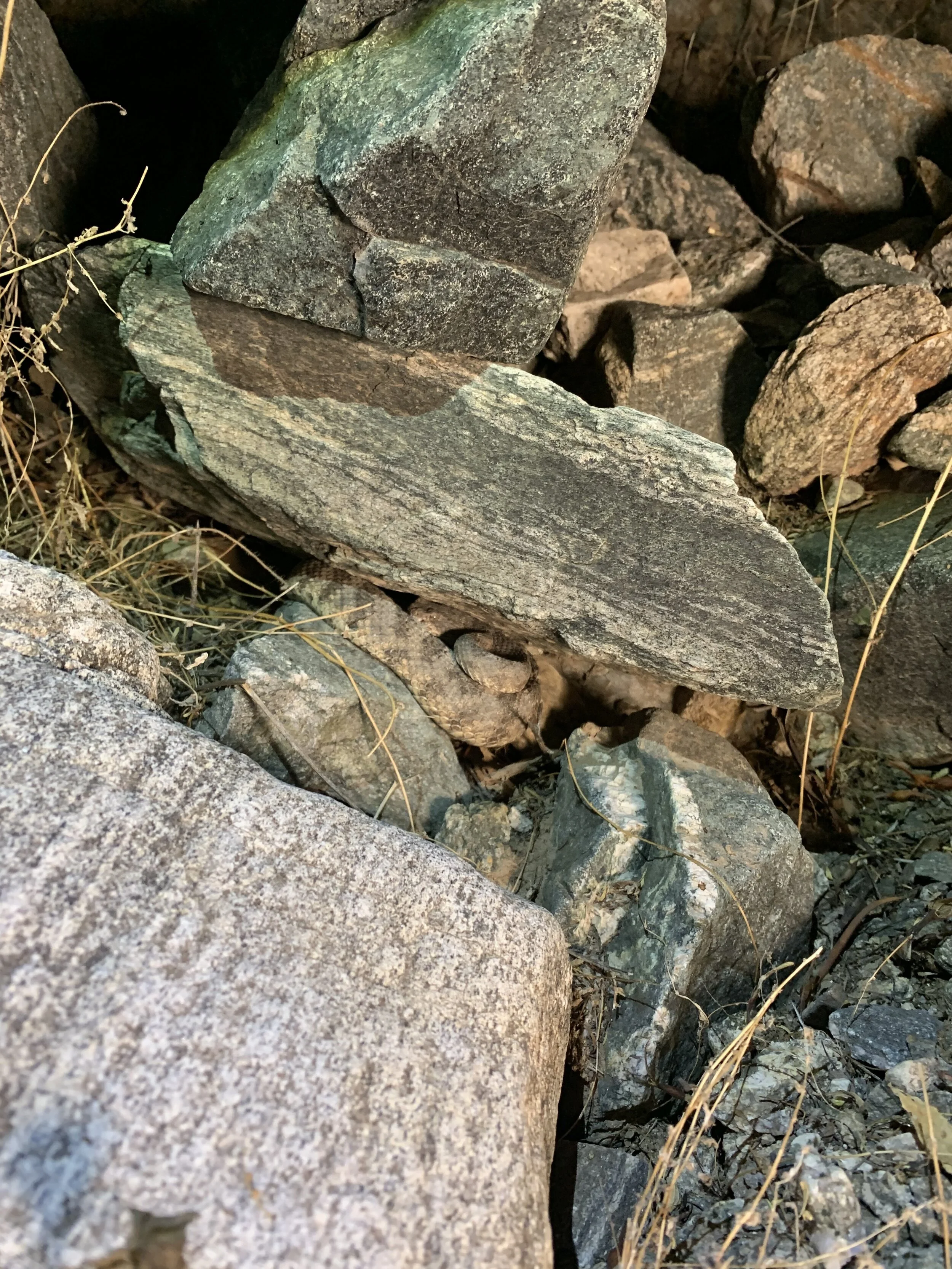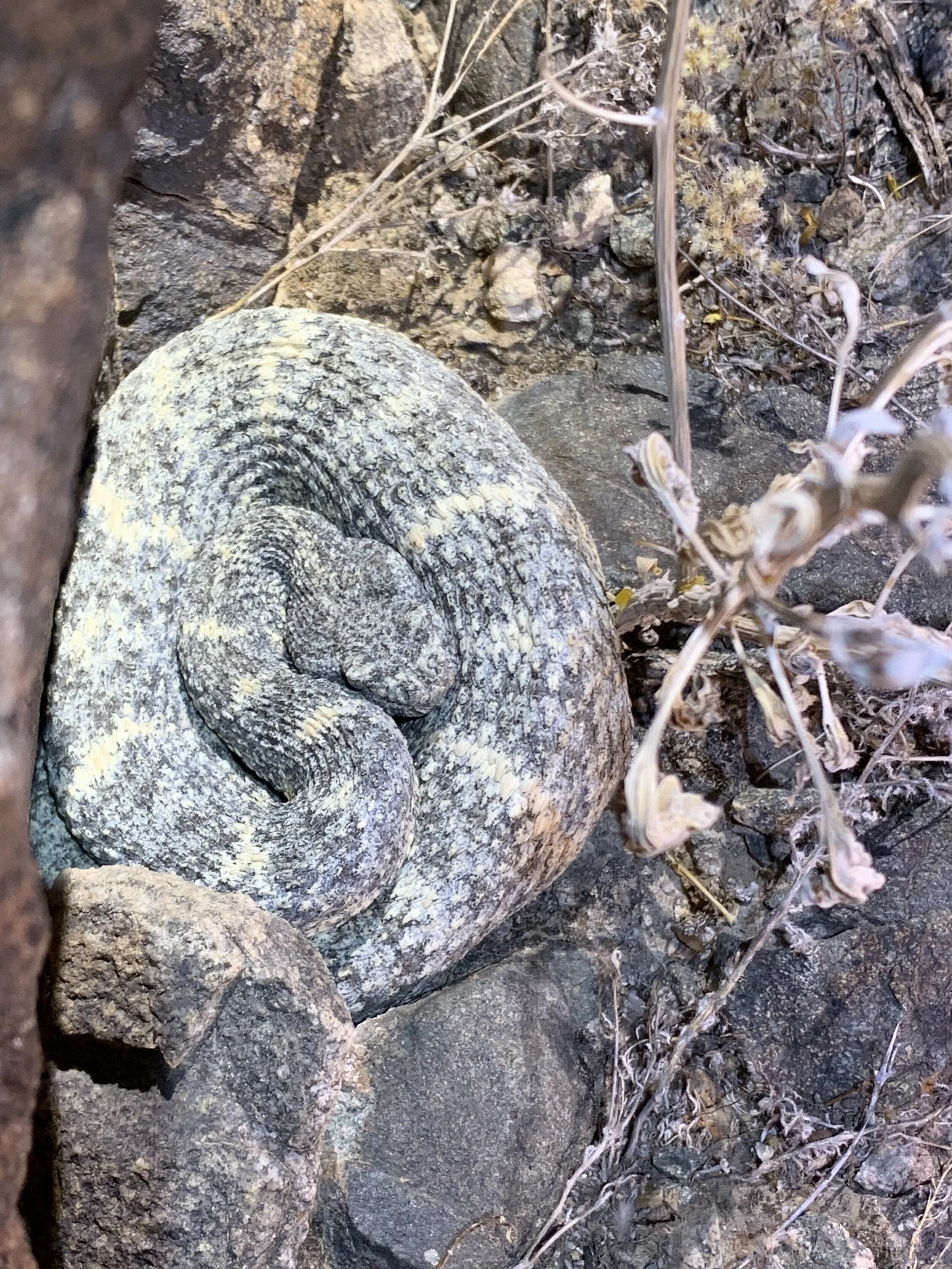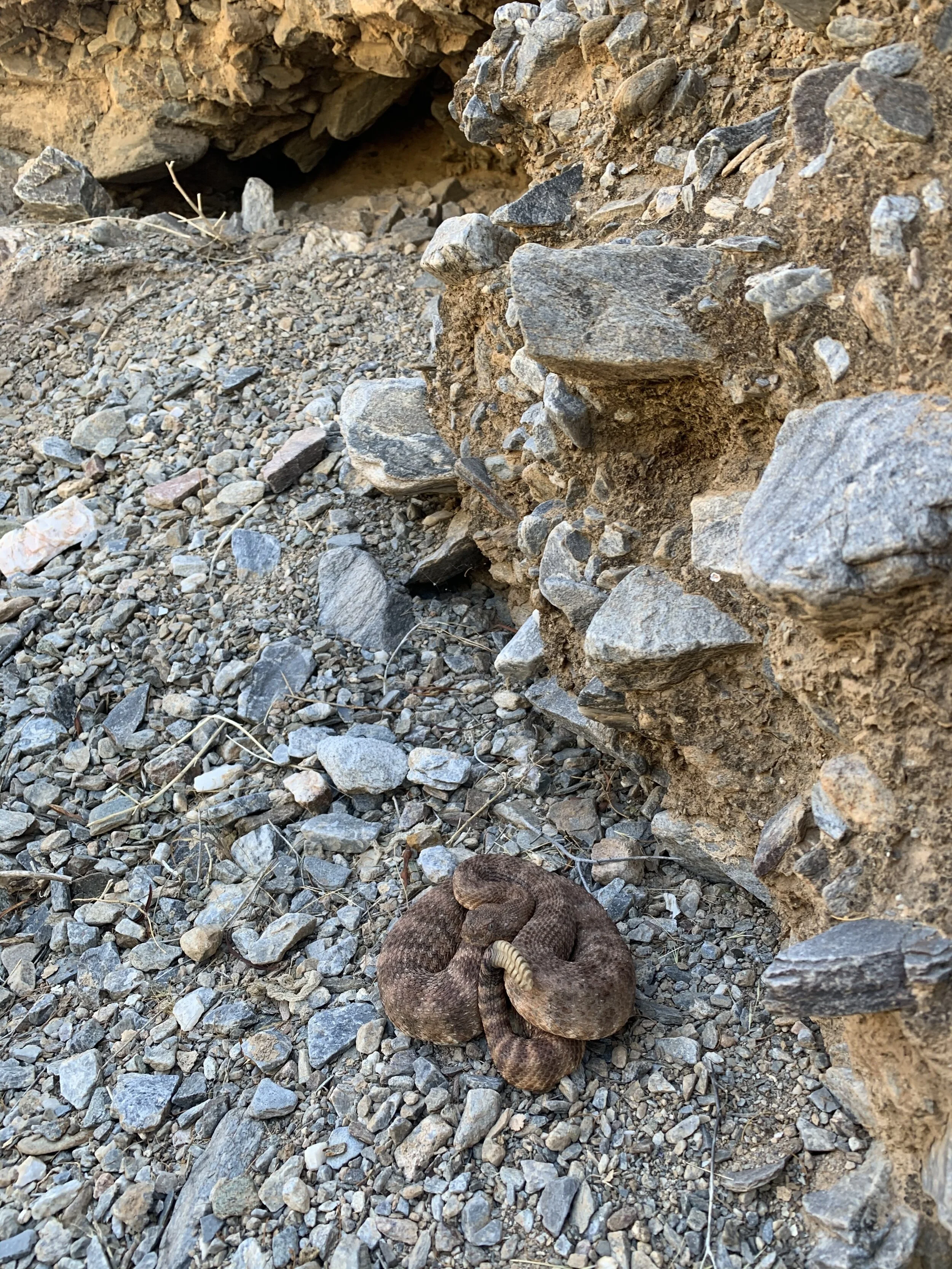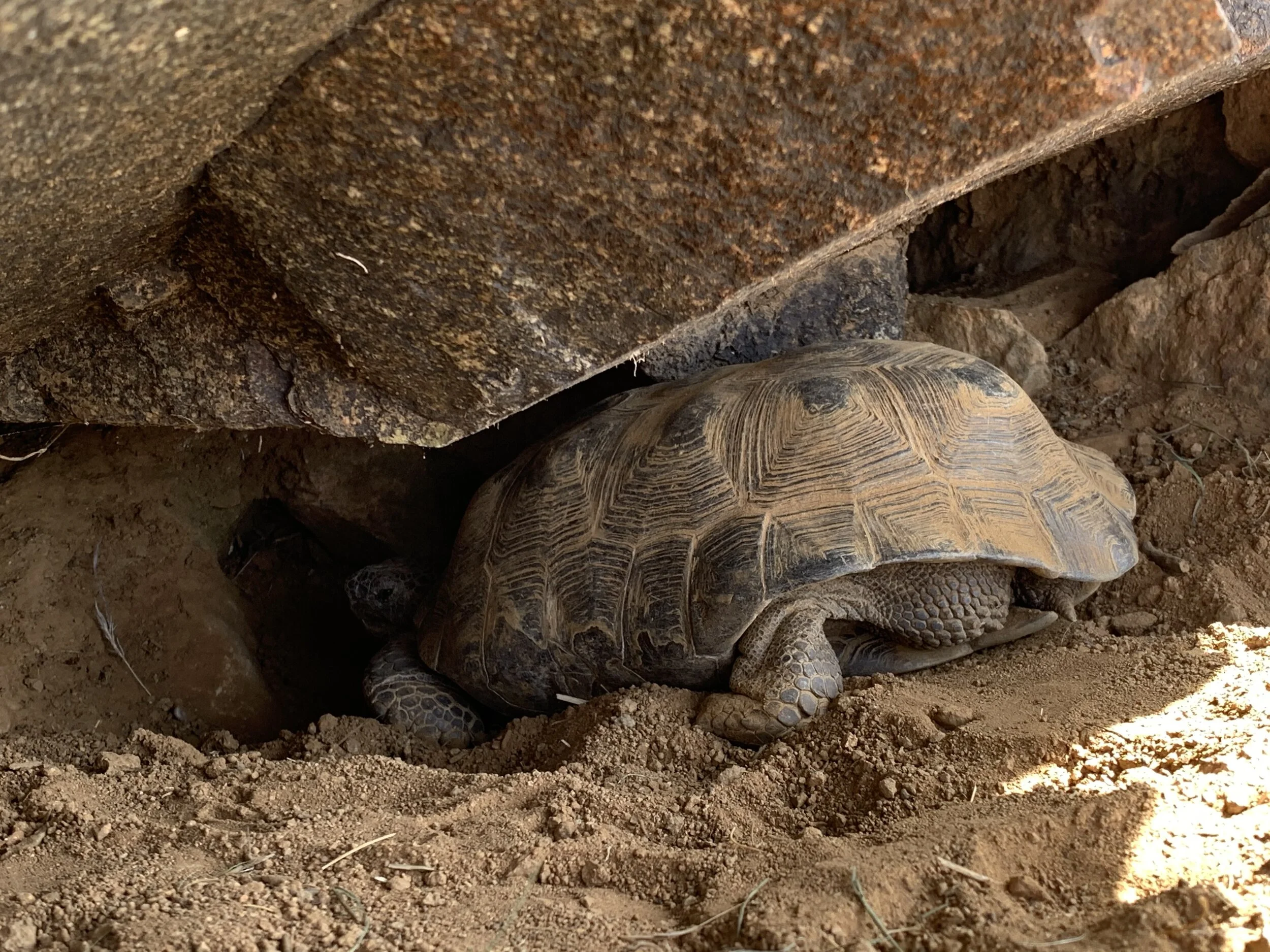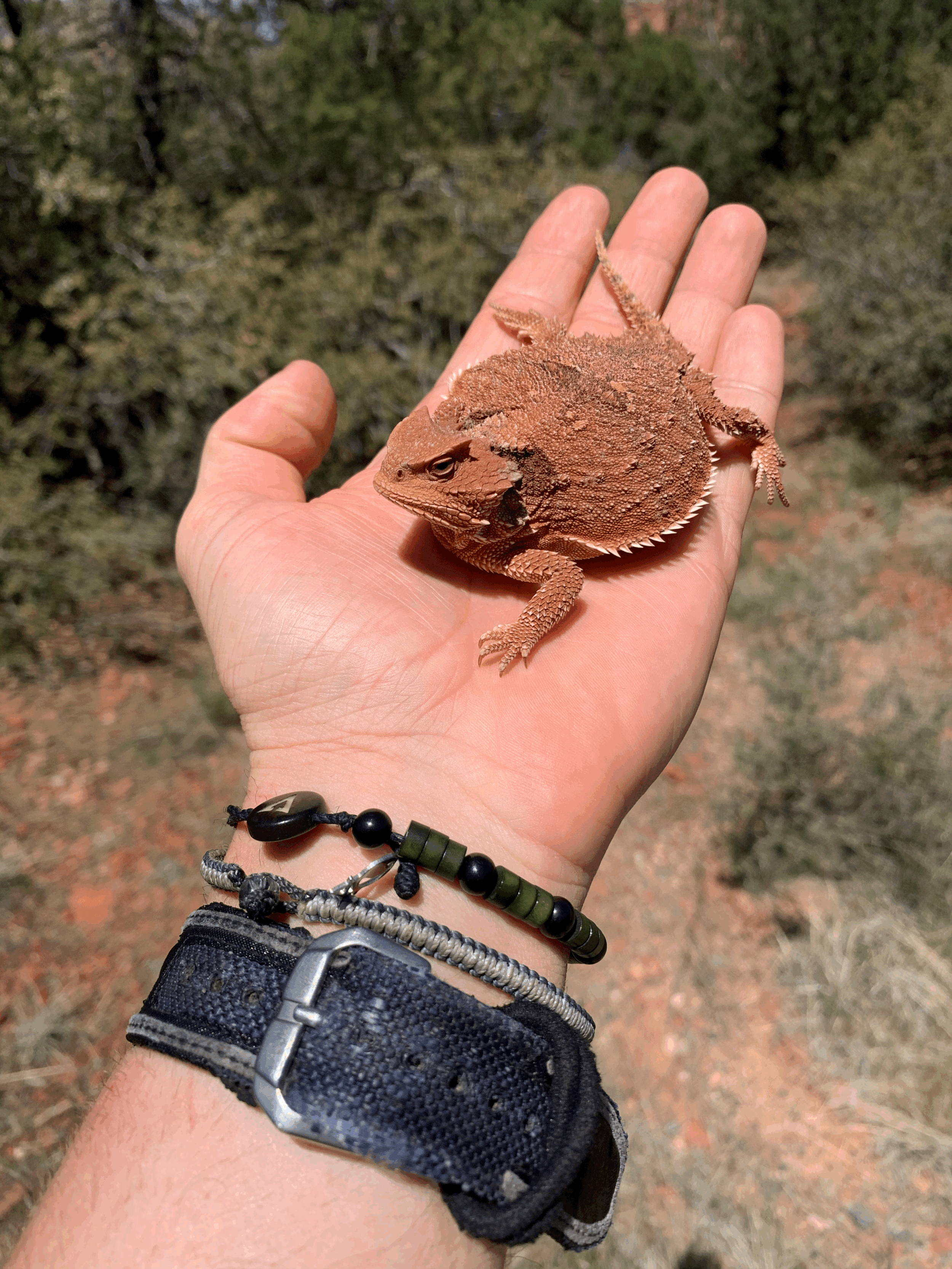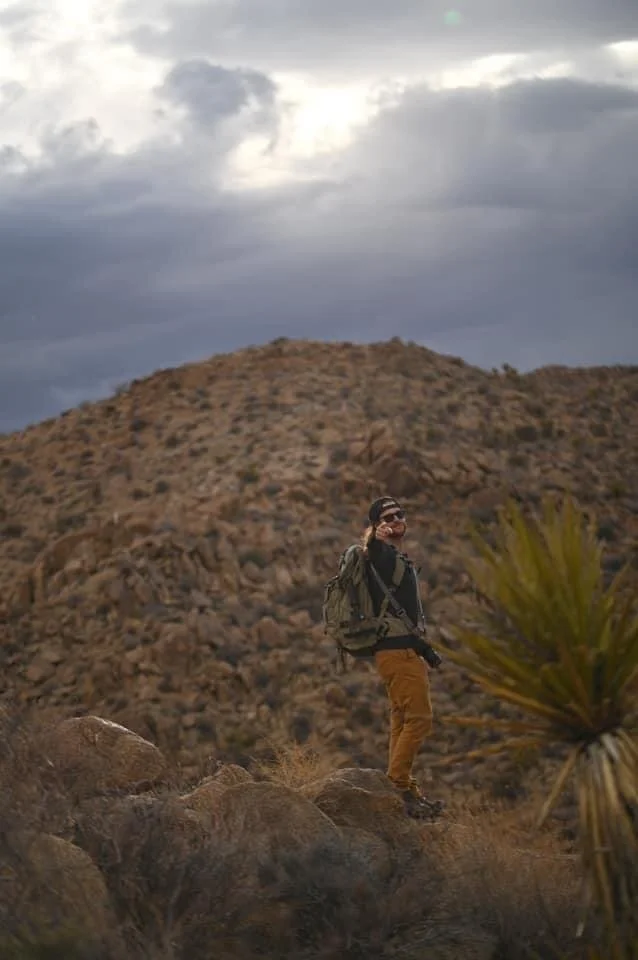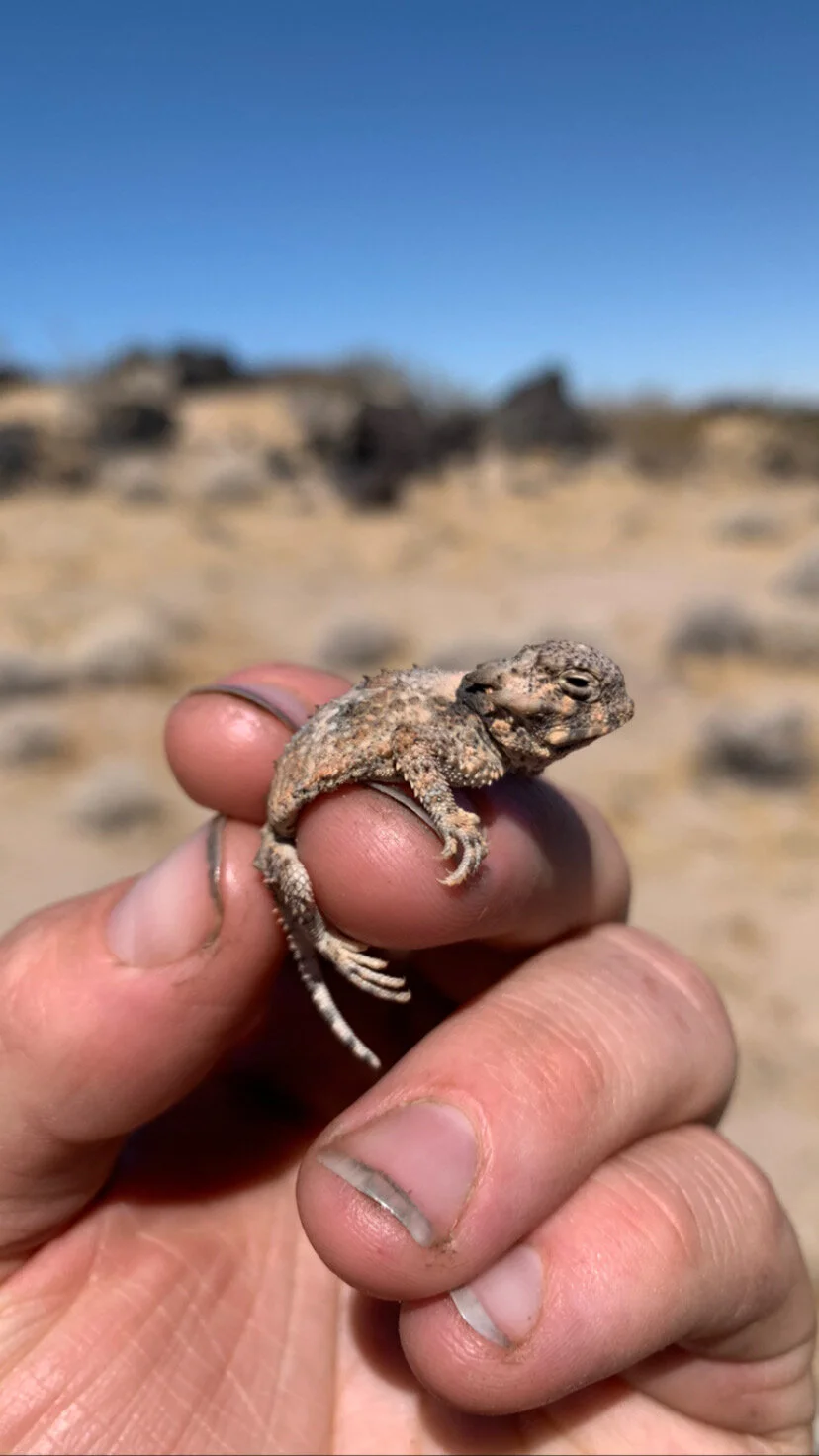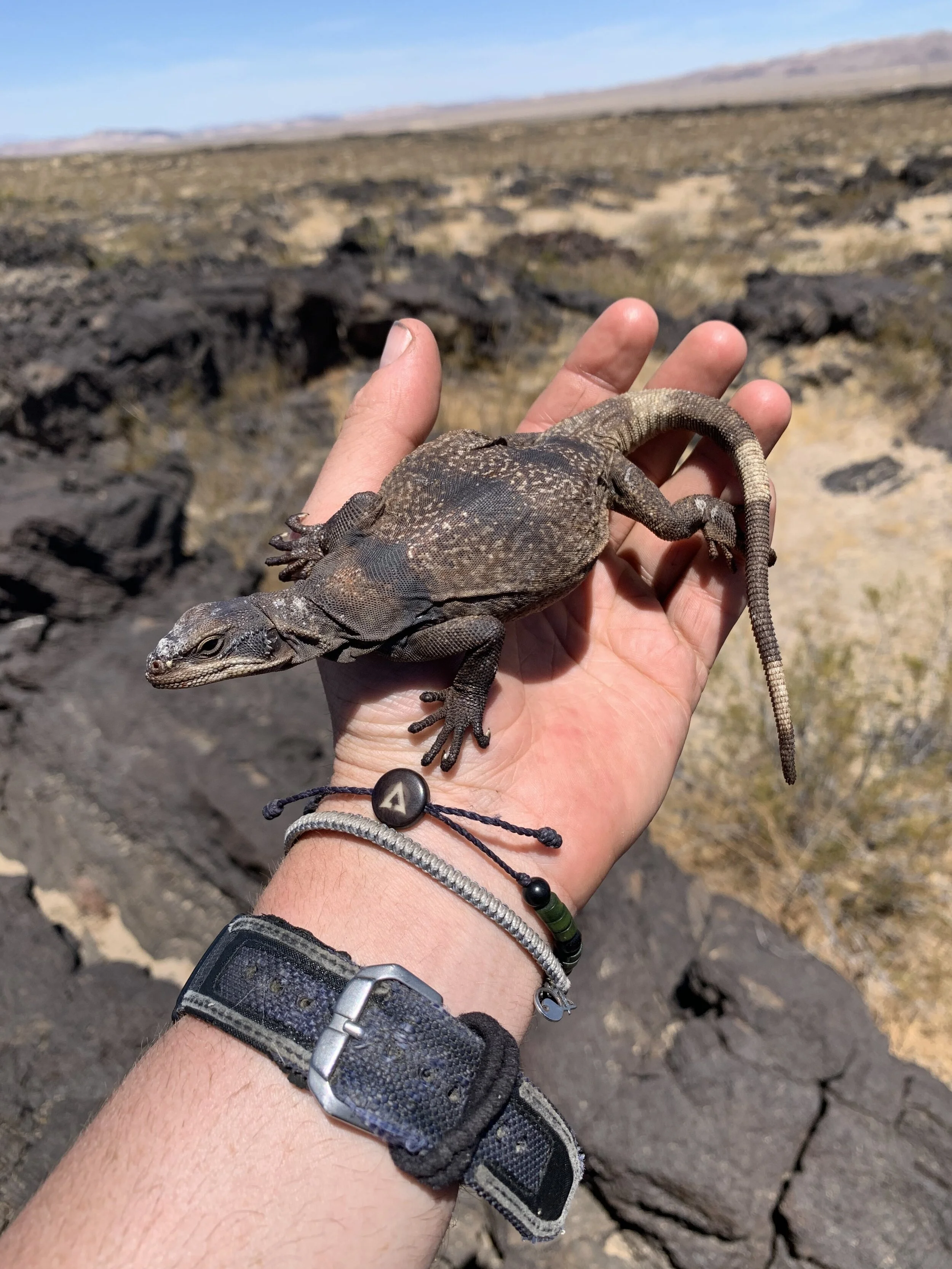Herping, Hiking, and Adventures in Arizona with Serpentine
Day 1
I hopped on the RTD train at 13:45 to get to the airport. The ride takes 35 minutes from downtown Denver. When I arrived at the airport, I checked in, dropped off my bags at the counter, and headed through TSA. I always get stopped and looked at a second time due to the extensive camera gear I have in my bag. I met up with my other team member Ian, at the gate before boarding. The flight from Denver to Phoenix takes about two hours, and I worked on writing blogs and sponsor emails during the flight. We arrived in Phoenix at 16:40, got our bags and met up with Mike, who picked us up in the car
We headed to a Mexican food spot to eat before heading out to a great area to find blue speckled rattlesnakes, which was our target for that night. We got to the wash at 19:15 pm and started our hike with RJ, Rachel, Ian, Mike, and Trent.
The best way to look for snakes is to spread out and check the sides, under rocks, and in bushes in a wash. A wash is a dried-up riverbed. When the monsoon rains come, it causes flash floods, washing away plants and rocks. When it dries, the sides have nice caves that the snakes utilize as their hiding spots. While we still had light, we hiked without our lights and only used them to shine into crevasses to spot a potential rattlesnake. After 45 minutes, we came to a narrower section of the wash, and Trent and Ian were talking about seeing a tiger snake. Two seconds later, Trent says, "tiger rattlesnake," and I quickly headed over and ducked under a rock. In a crevasse, was a gorgeous grey colored tiger rattlesnake. Tiger rattlesnakes are misleading as they have tiny heads compared to their bodies, but they are most likely the second most toxic of the rattlesnakes found in Arizona.
We took some great in situ (photos as found) photos. Walking at night in a wash is not the easiest task as there are rocks everywhere, and you stumble your way while looking for rattlesnakes. I like to hang back and take my time looking for snakes, so about 40 minutes after the tiger rattlesnake, I hear Ian call out “snake and speck”. This is the snake we have been looking for. I rushed over to where I see his headlight shining about 300 ft in front of me. The whole group was congregated around him. As I got to the spot, I could see tucked next to a large rock, a coiled gem of a blue speckled rattlesnake.
The speckled rattlesnakes are our target for this episode of the show. This is because of their variable coloration. The color of the rocks where the snake is found dictates the color of the rattlesnake.
We each took videos and shot a video for the show, packed up our gear and the team continued up the wash. Rachel and RJ had to go to work in the morning, so they headed back down the wash while Mike, Ian, Trent, and I continued for another 30 minutes before heading back to the cars. On the way, I spotted a little scorpion crawling through some rocks, and Trent shined the black light to make the scorpion glow.
Scorpions glow under ultraviolet light due to a protein in their exoskeletons. What is fantastic is that scientists are still indecisive about what makes them glow. One prediction is that scorpions see in ultraviolet light, so the glowing allows individuals to find each other. We got back to the cars and head to Mike's place. We got into bed around midnight.
Day 2
I woke up at 6 am and got breaky going before we set off at 7:00 to meet up with Trent at a spot with red speckled rattlesnakes. There is a grace period when finding snakes, and you want to get out there when it is cooler while the snakes are out basking in the sun to warm up for the day. We started walking in the wash around 7:45 am.We were in a scenic wash with some short climbing spots. Around 8:45 am, we hear Trent call out "snake" and “red speck”, so I rushed over there as this is the first time I have seen red specks. I reach Trent, and sure enough, there is a gorgeous red speck.
It gave us a slight rattle as it was nice and toasty and most likely moving to get into a nook for the rest of the day. We moved out of the sun and into the side of the wash. We photographed the snake and filmed it for the show. It was getting hot, so we headed back as the snakes and reptiles will not come out during the day. We worked on some computer stuff that we needed to get sorted out.
We had a group of our reptile friends come out to Mike's house, and we grilled some food before heading off at 17:30 pm to road cruise an area in the north that had a wide variety of species. Road cruising is when you cover large distances with your car to find snakes crossing the road. We had two cars going out. I was in the car with Bryant, RJ, and Rachel. Trent, Ian, and Mike were in Trent’s car. This way, we increase our chances of finding snakes. We got there about 30 minutes before sunset and started cruising. We had not seen any snakes crossing the road, but I saw a large shape sitting on top of a tree and it was the unmistakable silhouette of a great horned owl.
We stopped to check it out, and there was a nest nearby with a baby. We admired this epic bird and headed back onto the road. Another pass and then as we were heading back, we saw the little stick looking shine and it was unmistakably a snake. We whipped a U-turn, and I got out of the car. It was a little long nose snake.
This one had low oranges but lots of black and white. I called Ian, and they came over so we could photograph the snake. We let it go and continued road cruising. About 20 minutes later, RJ spots a snake on the side of the road, and we jumped out. We thought initially it was a western diamondback, but it turned out to be a Mojave rattlesnake.
Both snakes look similar, but the Mojave has two large scales between the eyes, while the western diamondbacks have 4-5 scales between the eyes. We let the Mojave go and continued.40 minutes later, Trent’s car spotted a Californian king snake and called us over. These snakes have gorgeous black and white bands and are snake eaters. That is why they get their common name, the king snake.
It was getting late, so we drove back to Mike's place. We crashed a little after midnight.
Day 3
We woke up a little later to head to the Phoenix Herpetological Sanctuary to photograph and video their Gila monsters. Gila monsters are protected species in the state of Arizona. When we find one, we cannot work with it. We got there and were able to see three of their Gilas. One of the Gilas was a baby, which was stunning and had such high bright oranges. One of the adults was a more prominent black individual with only minimal orange.
After working with the Gilas, we toured the facility and then headed out around midday to Mike's house. Once we got there, we hiked up the mountainside where Mike knew of a desert tortoise that made up his burrow under a rock shelf.
That day we had to tackle issues with websites and our funding campaign, so we worked out on that for the rest of the day.
Day 4
We got up later today as we were planning to head to Sedona, which is known for its stunning rock features and landscapes. The group headed out around ten, and I was with Trent, Rachel, Ian, and Mike. We got to the city just before noon and wanted to make it to the Soldiers Pass trail. We got near the trail, but there was no parking, and where we would park would have added an extra hour to our hike. We chose to skip that and head to the birthing cave, which is a gorgeous photography spot. We found the King Canyon trailhead. Trent was on a phone call, and I was in the passenger seat. Mike got out of the car to stretch his legs. The next thing I know is, I look up and see him holding a greater short horned lizard.
I was so happy to see one as I love these lizards. The horny toad was large, so I looked under to see if it was a male or female, and I identified it as a female. The tail was not thick, and near her cloaca, she did not have the prominent scales that males do. We got some gorgeous photos of her and left her to enjoy the rest of her day. The rocks around here are bright red and there are dark green juniper and manzanita trees. We hiked up the path and kept left to head to the birthing cave. It took us about 20 minutes before we got to the side of the mountain where the cave is located. We started climbing up to the cave. It was a little crowded, to begin with, some people around the cave, so I put down my pack and climbed up this sketchy rock face with limited traction, footholds, and handholds. There is a little ledge that one can perch upon to get a great view of the cave and valley in front of it. We hung out there getting photographs of the gorgeous cave for about 30 minutes.
When we got back to the car, we decided not to do Devil's Bridge as it would take a while and it is also very touristy. So, we headed to an area near Oak Creek to check out some spots but turned up nothing.
The air started to cool off, and storms were coming with rain making the temperatures not ideal for searching for reptiles. We decided to hike on the Munds Wagon trail in the Secret Mountain Wilderness area, leading to the Hungover trail, which takes you up into the mountains. We took a lot of photos of each other walking up to the top as the area is gorgeously scenic. I get ahead of the group and am the first one to make it to the plateau.
The view looks over the city of Sedona. At the top, the wind had picked up due to the approaching storm. Luckily, it was not moving towards us and was hugging the north side of the valley. While I was enjoying the view, the rest of the crew caught up, and we took fun photos of ourselves on the ridge looking over the valley.
It started to sprinkle and was getting dark, so we got in the car and started our 2-hour journey back to Phoenix at 19:45. We got back at around 22:00, and since the weather brought rain, we looked at places that would be good in the morning for herping, since the water would bring out abundant wildlife especially since it has been so dry recently.
Day 5
Today I woke up around 6:00 as we were going to drive an hour and a half to a cool spot that Trent thinks will be great due to the rain that fell the night before. This area should have the bright pink speckled rattlesnakes we want to find and film. We got on the road around 7:30. Around 8:45, we got to the spot and walked down into the wash over some sketchy ankle breaking rocks and got onto the flat sand bed of the wash. Ian, Mike, and I walked into the wash while Trent headed to a higher area. I set my bag down to put on some sunscreen because redheads in the bright sun are not the best of combos.I was handing my go pro to Mike when we both hear Trent yell out, “Guys come here,” without being specific about the animal. I yell back, asking if it is a speckled rattlesnake, and Trent says, just come here, and that means two things. It is not a speckled rattlesnake but something just as cool. I had two animals going through my head on what it could possibly be. It is either a Gila monster or a rosy boa. Mike and I quickly run over to where Trent was, and as I turned the corner, I saw an absolutely stunning adult Gila monster out on the crawl.
Trent had gone to take a pee and heard something rustle in a bush and found the Gila. I have also had my fair share of finding cool animals while urinating. The Gila monster went on the move, and we got great photos of this beautiful lizard. Most people do not get to see them in the wild as they are quite rare. This is only the second Gila I have ever seen in the wild and my first adult. The last time I was in Arizona, I saw a baby that was about 6 inches long. Because it is illegal to handle them, we took our photos without disturbing the Gila and went back into the wash. The wash went through a hilly area which had this gorgeous canyon, so I got some photos of Ian and Mike hiking around. We scrambled up what would normally be a waterfall area if it were not so dry.
Mike and Ian went to the left of me to a rocky outcropping, and Trent kept walking the ridges farther to the left of me. I continued hiking in the wash, checking the sides for snakes. At this time of day, it is best to look for snakes in dappled light, which is when the sunlight comes through a tree and creates patches of sun and shade. I find a smaller wash to walk up to check my bearings and see where the guys were. They were out on another rock cropping searching for snakes. I drank some water, and Ian called out “tortoise”, but I was too far away and did not go.
I set out back to the wash. Eventually, Ian, Mike, and Trent caught up. While I was in the wash, Ian was up on a mound of rocks and called out "snake." At first, he said “speck”, but when he got a better look at the snake, he identified it as a western diamondback. I had my snake hook, so I ran up to help Ian since the snake was on the move. I put my pack down and started hooking the snake to keep it from getting away from us. I got the snake to calm down a bit and then brought it to a more open area for photography and to talk about it for the show. Mike got a little close with the go pro, and the snake struck and covered it in venom. We did not want to bother the snake any longer and wanted to keep it out in the sunlight, so we got our photographs and let it go under a nice rock.
We headed back to the car since it was starting to get hot, hoping that on the way, we can spot a speckled rattlesnake and the color variation we want to find. Trent and Ian were walking ahead of me and Mike was behind. I hear Mike call out, “snake” but also, he said he could not ID. I went back, and we could hear the iconic rattle sound these stunning snakes produce. We lifted some debris out of the way, and we were able to identify another western diamondback. Since we already got one, we did not take photos and continued looking for snakes. We hiked a little bit farther and came to a rocky outcropping that Trent said looked good. About this time, we were about 3 hours into walking in the Arizona heat in open sunlight. We fanned out into the rocks in hopes of finding a speckled rattle tucked in the rocks during the heat of the day. Mike was to my left, and Trent and Ian were to my right. About 20 minutes later, I got down from the rocky area into a low area, and Trent was in earshot and stated, “it’s getting hot and I’m getting hungry”, which is the vibe everyone was feeling. I head up this hill, check for snakes, and glance past a rock with a shaded patch. In this shade patch was a circular stone. Then my brain registered it as a rattlesnake, and then a quick look around the pattern, I saw pink and orange. The build-up of excitement hit me so hard. I started yelling, “YES! We got one!” The others quickly rushed over and were equally ecstatic about finding the speckled snake we spent so long looking for.
It has taken us around 4 hours to find this snake. This is what field herping is all about and what we want to demonstrate on the show. You need to be dedicated to doing your research and spending the time looking for the animals. Herpers, and herpetologists put so many hours into research, hiking, and post-editing photos, but it is so rewarding when you find the one animal you set your sights on. We photographed this stunning snake and filmed it for the show.
We set the snake in a shaded area and then hiked back to the car. It was 1.5 hours back to Mike's house, where we packed up and headed to Tucson, where we will meet up with my uncle as he lives down there. We will crash at his place for the next couple of days. We left Phoenix around 18:30 and got to my uncle's place at 20:30, relaxed and worked on computer and film stuff for the rest of the night.
Day 6
I work up at 7:00 this morning because we are leaving at 8 am to head to a mountain range south of Tucson and close to Mexico. Today we are after the mountain rattle snakes. There are three of them, and we are targeting two as the third, the twin spot rattlesnake, lives in high elevation and would not be out at this time of year due to the cold temperatures. The two species we are looking for are the ridge nose and banded rock rattlesnake. It took us about 1.5 hours to reach the spot we were going to hike. What is crazy is that we were only 4 miles or so from the border of Mexico. This area has some of the best biodiversity on the planet. We got to meet up with part of the TV crew from the YouTube show, Brave Wilderness. Trent and Mario used to work together in south Florida as Mario was known for his work with American crocodiles. He and I have been following each other for some time now, and it was cool to finally meet him in person as I have used some of his research papers for references in my papers for university. One of my favorite things about social media is meeting up with the other extraordinary people out in the natural world. After an introduction, we got our gear ready and headed up the wash. The snakes are small, so we are taking our time to check everywhere for them. Next to trees, under overhangs of rocks, and out on the crawl. Our group of six fanned out, with some walking in the wash like me and others walking the hillside. About an hour passed when we heard the most beautiful sound in the herping community, and that is “SNAKE!” I flipped on my go pro and headed back to where Trent called out. I needed to play a little “Marco”, “Polo” to locate where he was and get headed in the right direction. When I got to the spot, I looked down under the edge of a log, and coiled right there was the Arizona state reptile. The ridge nose rattlesnake (Crotalus willdari) is a mountain species of rattlesnake that live in very isolated populations in the sky islands of the western United States.
Sky islands are mountain ranges that do not connect to other mountains and are separated by vast flat low desert. We took our photos and a video of this stunning snake and left it next to the log and continued to search for the other rattlesnake, one I especially wanted to find, which is the rock banded. I have never seen one in the wild. Everyone spread out again and I went back into the wash. About 40 minutes later, I hear Mario yell out that he got a snake. I headed over to him, and low and behold, another gorgeous ridge nose rattlesnake. This time, however, it was a young one and most likely born last year. The snake was tucked up against a tree, and we were able to get stunning photographs.
We spent another two hours hiking and searching for snakes, and it was getting close to 13:00. I hear everyone mentioning we should start heading back soon. Ian and I came to a fenced area, and I checked this big log that looked perfect for a rattlesnake but no luck. I moved more into the wash and walked past another log and hear a little buzzing sound. I look to my left to see a little tiny rattlesnake nestled in the crook of the log. This snake was it. The banded rock rattlesnake (Crotalus lepidus klauberi). I yelled with excitement, “Yeah!” as this is a lifer for me. That is an animal you have never seen before, and I found it myself, which makes it that much better. My favorite thing about these rattlesnakes is their banding. It is so solid with zero gradients from dark brown to grey. Another cool thing is when they are young like this individual, the babies have bright yellow tails that they use for caudal luring.
This is when a snake wiggles its tail to attract prey that thinks its tail is a worm. After filming me talking about the snake, we headed back to the cars. It had been a very successful morning. We then headed to an area known for green rat snakes, which are moving around this time of year. It is a gorgeous canyon that the rat snakes tend to hang out in, and we start to road cruise for them. We got to the spot around 5 pm as the sun was getting low, and that is when they tend to move. We had enough people for two of us to hike the wash next to the road, and Mike and I volunteered. After an hour of hiking, we did not turn anything up and met up with Trent and Ian who had not seen anything either. The road was hectic since it was a weekend. While driving back, we saw a snake on the road, and swerved out of the way but unfortunately and way too common, the car behind us clipped it, so we headed back to see what species it was. It was a juvenile gopher snake, and it was still thrashing around after having its head crushed. That is the worst feeling you get as a herper when you come across snakes that have been killed. We put the snake out of its misery and headed back for the night to get some rest for the epic days ahead.
Day 7
We woke up later today as we did not need to head out immediately because we were going for Arizona black rattlesnakes before making the long drive to the southwest part of the state. The Arizona blacks are found in higher altitudes and are an endemic species to the state of Arizona. They can either be grey or black with tan banding. We packed up our stuff and headed out around 10:30 am to a sky island. While driving, one of my favorite things is the climb up from the valley to the top of the mountain because you can see the change in altitude based on the surrounding environment. The blacks like to be around pine trees since they live so high. We started the hike and came to a rock face that looked good.We started hiking up a very sketchy incline with lots of loose soil as a fire had gone through not too long ago.
After 2 hours of intense chill climbing with no luck, we headed back to the cars. We drove to southwestern Arizona, where we would camp for the night and search for an extraordinary color variant of a speckled rattlesnake. It was a three-hour drive to where we were headed, and we grabbed stuff from the grocery store before we headed out of Tucson around 15:00. The drive was long, so I was able to catch up on this blog I am currently writing. We got to the gas station, where we would meet up with Rachel, Dane, and Daniel, who would be camping and searching for snakes with us for the rest of our time in this mountain range. We drove through the desert to our campsite, parked two cars, and then everyone got back into the other cars with their gear for the night hike we were about to do. We got to the wash after a very bumpy 15-minute off-road ride. We park, get packs and lights on to start walking the wash.
The crew fanned out in the wash to search for snakes. I was in the winding between the rocky hills and wash, and that is kind of how everyone is doing it as all these places look suitable for the snakes. I hear that gorgeous word, “snake” from Ian, and rush over to see my first ever white speckled rattlesnake. Ian found the snake by buzzing it. That means you discover the snake by hearing it rattle before you see it. David then spotted a Lyre snake as well very close to the speckled rattlesnake.
We photographed the snake, and then I headed to the left side of the wash. I came to an area with heavy plants and found a female hummingbird moving around, distracted by my headlight, so I admired this gorgeous bird. I follow it, and as I am shining my light wherever it lands, my light catches a glimmer of white light like a white stone under some brush—no mistaking this other than another gorgeous white speckled rattlesnake. I was excited, as this was my second spot for this species of the trip. We hiked for about another 1.5 hours, and the only other exciting thing that happened to me was getting the shit scared out of me by a hummingbird that got startled and flew right in front of my face. It was getting close to midnight, so we headed back to the cars and drove the 15 minutes back to our campsite for the night. I was tired, so I immediately set up my camping pad, laid out my sleeping bag, blew up my inflatable pillow, and went to bed while the others made a fire. Luckily, I have excellent earplugs and clocked out for the night.
Day 8
Around 4:00 I woke up, and it was cold, so I needed to huddle in the fetal position for warmth. I woke up again around 5:30 to take a leak, and as the light started to come up, you could see it was overcast. It was going to like this the rest of the day. We arrived at the site at night, so this was my first time seeing the surrounding area. What stuck out was a huge black lava mound. We got oriented and headed out to the wash again to look for the speckled rattlesnakes. On our way to the wash, a sidewinder went across the road, and we all jumped out to photograph it. Where we stopped David
We spotted both rattlesnakes that we had seen the night before and got photos of them.
While everyone was hiking in the wash, I hiked up to the hill so I could get pictures of everyone looking for snakes with the surrounding landscape.
I wanted a photo of this black lava mound, so I headed back toward the cars to find what I thought would be the best spot for a photo. While scanning, I saw a gorgeous saguaro cactus and knew that was the one I wanted to be in the shot. The rest of the crew came back in the cars, and I snapped a great photo while Ian and Mike were riding in the back.
I ran over and jumped in, and we made it back to the campsite. We made sandwiches and then packed up. When I lifted my sleeping pad, I discovered that I had a visitor the whole night. It was the largest camel spider I have seen in the states yet. These crazy looking animals belong to a group of arachnids called solifugae, also called sun spiders. Their huge mandibles easily identify them.
I picked it up and let it crawl all over my hands as they are harmless but look scary. I let the camel spider go, we loaded up into the cars and headed out to the sand flats to look for the endangered flat tailed lizard and sidewinders that live there. It was around 14:00 when our group arrived at the sandy area we would be hiking, and it was windy with a temperature of 18c/65f. The conditions were still good to be able to see the reptiles we were after. Trent mentioned that the lizards at this time should be out basking instead of being buried under the sand. It turns out searching for these lizards is the same way as we did it in the UAE. When I lived out there, we would find the animal's tracks and then follow the tracks to find them. Unfortunately, the wind was making tracking difficult. About 30 minutes later, Trent came up to me to show me what flat tailed horned lizard poop looked like. Horned lizards have almost an entire diet consisting of ants. When you break up their poop, you will see ant parts.
We continued searching for lizards when Ian called out "snake," and I rushed over. Tucked under a bush was the most gorgeous pink colored sidewinder I have ever seen. Usually, they are a shade of tan, but this one had the pink coloration, which is typically a characteristic of the ones found in Utah.
We already filmed a sidewinder, so we only took photographs and went back to searching for flat tails. We were heading back to the car when Rachel behind me yells “snake”, and I look where she is pointing and see black, orange, and tan banding and thought coral, but knew they were not down this far south. Ian jumped into the bush and grabbed it by its tail. It was a stunning shovel-nosed snake, which is a fossorial species that spend their time underground foraging for insects.
After that, we headed off to another mountain range and looked for specs till sunset, but we did not see any. That night we got a hotel to shower as we were going to be camping the next couple of days.
Day 9
We woke up later as the temps would be better and headed back to the spot with the flat tailed horned lizards but had no luck. We then went to a coffee shop and booked our tickets to Peru.
We had a two-hour drive to one of my favorite places in the United States. We were going to Joshua Tree national park. We went to the south side as it was better logistically for what we wanted to do. We met up with Rob, from Kings of Pain, at the south entrance of the park, and then we headed to the Cotton Spring Oasis, which has a unique species of palm tree that we were able to admire up close.
We walked a wash and then headed out of the park to meet up with the others that night for camping. On our way to the camp site, Mike was driving, and our exit was coming up. I said, “turn right up ahead.” When Mike talks about China, he gets distracted, so he continues going straight. Luckily, we were able to get off the highway via an underpass. We got to our site, went on a bit of a night walk, but the weather conditions were not great, so we headed back and grilled some food before going to bed. It was a frigid night, so I had to put my beanie, jacket, thermal, pants, scarf, and neck gaiter on to be warm.
Day 10
I woke up around 6:30 as cars were passing us and the sun started to warm me up.Most of the people that came to camp just for the night began to head out, and Trent, Mike, Rob, Ian, and I headed to an area that Rob knew would have speckled rattlesnakes and a unique color variant as well. At this site, they tended to have high grays and browns. After about 3 hours of hiking various mountain edges looking for a snake, I pass Ian in a wash and head down while he goes up. Five minutes later, I hear that beautiful word “snake,” and turn on the GoPro and rush over. One thing herpers love to do is spot the snake and have everyone come over and try to find it.
We took photos of the snake and what was cool about this is that Rob had brought his bite resistant gloves so I could handle the rattlesnake. I love how calm speckled rattlesnakes are. It was magical to handle the snake like this, as it was my first time using these gloves.
We filmed, took photos, and headed down to our cars. We ate some lunch, and Ian launched the drone to get epic landscape views of where we had hiked. Then we did the drive through Joshua Tree national park. The bottom section of the park is the Lost Palms Oasis where I want to backpack one day. There is a lot of desert in the southern area of the park, but once you hit the northern part, the Joshua trees start to rise, and the massive boulder piles that I love start to become more apparent. We headed to a hiking trail that I had camped near the last time I was in the park in the fall of 2019. It was very windy, and we did not find any reptiles, but it was still stunning scenery
We headed two hours north to hit an area we think would be great for Panamint rattlesnakes and rosy boas. We got there right as the sun was going down and started exploring. I walked up and down a wash and flipped rocks but still did not find anything. As the sun was getting low, I randomly checked my Instagram and saw a message from Rob saying he found one. I called out to the rest of the crew, who were on the other side of the road from me and up a hill. I started to run over to where I thought Rob was located and eventually see him behind me flashing his light. I ran up to where he was, and he said, “find it.” Tucked under a bush was a gorgeous bright red Panamint rattlesnake. This is another lifer for me as it is the first I have seen in the wild. We took photos as the clouds in the sky were turning amazing hues of orange.
We went back to the cars, headed to our camping spot for that night where I started a small fire, and we got to bed around 23:00.
Day 11
I woke up around 7 in the morning, and as the sun started to rise, my sleeping conditions got hotter. Unfortunately, our dumb asses did not run to the store the night before, so we had hardly any water and no food for breakfast. That did not stop us, though, from getting out early and looking for the snakes. We were hiking in a lava field, and since the landscape is dark, it absorbs a lot of heat, so the temps rise quickly. We searched every nook and cranny in the lava field. Honestly, this was the most challenging area we have hiked yet during the trip. The terrain is lava rock which is razor sharp and unstable, but this offers more places for snake to hide out.
We spent about an hour or so filming a sequence with me speaking, when Mike walked over the hill chanting, “Chuckwalla”. One could see he held a good-sized chuckwalla. These iguanids are remarkably adapted to desert life. They even spray out salt from their noses due to the salty plants they eat. A couple hours of hiking later, I am feeling the first signs of heat exhaustion because of my lack of water. I was walking near the volcano's edge and got a call from Trent, who tells me Ian found a horny toad. One cool thing about the desert horny toads found here is their predominantly black coloring due to the black lava rock. The little horny toad that Ian had in his hand was more sand colored with some lovely pinks. I took some photos of the active little guy in my hand and then got my camera so I could get a macro shot. Well, as soon as I set him on the sand, he bolted under an unmovable lava rock.
Luckily, we got an epic horny toad earlier on in the trip, so the others were not that bummed out by not seeing it. At that time, Ian received a call from Rob saying he is taking off since it was getting scorching hot, and we were all dehydrated. 30 minutes later, Trent picks up his phone and says, “you got a snake?” and he yells at me that Ian found one. It was the speckled rattlesnake we have been looking for in this area. I turned on my GoPro and made my way to where I thought Ian was located.
I walked over a bit of a hill, and saw that he was in u-shaped lava area, pointing his camera at the ground. As Trent and I walk up, Ian says, "be careful as this snake could bolt easily." As I am trying to spot it, Trent says, “it’s moving, I’m going for it,” and with lightning reflexes catches the snake by the tail and hooks it into an area where we can work with it. This is the largest speckled rattlesnake I have ever seen. The snake was around 1 meter in length. Rattlesnakes, especially desert species, are not big snakes by any means. We photographed it, and we were so happy because this was the wrap for episode 2, our final target, and we got it. We hit every target we had for speckled rattlesnakes and got to see other amazing animals along the way.
We headed back to the cars and relaxed there with a cool beer. Mike had the genius idea to shotgun a beer and then immediately started throwing up. Hypothesis: Dehydration and shot gunning beers is not a good mixture. We packed up the cars and headed for LA to stay at a friend of Mike's house near the beach for the last 24 hours of our trip. Ian and I flew back to Denver and Mike drove back to Phoenix.
Thank you for reading this blog. It means so much to me that people find my stories entertaining, and I cannot wait to share more with you.

